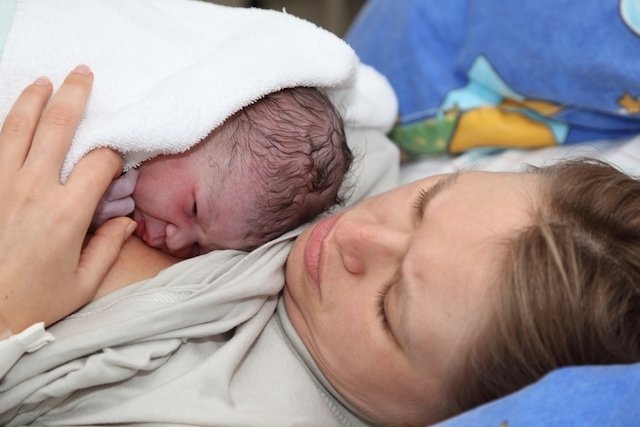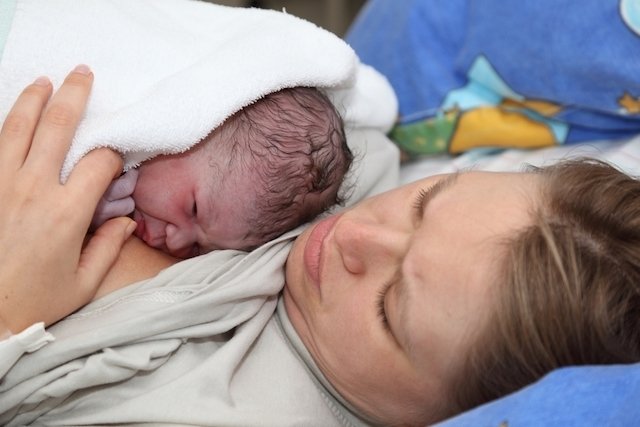Breech birth occurs when the baby is born in the opposite position to its usual position, as it is sitting inside the belly during birth. This causes the baby’s feet or buttocks to come out first than the head.
If the baby is not turned upside down between the 36th and 38th week of pregnancy, the pregnant woman can do stretches to help the baby turn upside down. When this is not possible, the obstetrician can perform an external cephalic version, which consists of turning the baby through specific maneuvers on the pregnant woman’s belly. Check out 4 exercises to help your baby turn upside down.
If, even with the maneuvers, the baby does not turn and all the conditions are met, the breech birth can be carried out safely. Still, there are some cases, such as when the baby is very heavy or premature, or when the woman’s health does not allow it, in which a cesarean section may be necessary.

When is indicated
Breech birth can be indicated whenever the baby is in a sitting position at the end of pregnancy, and both the fetus and the pregnant woman have all the requirements for a vaginal birth. See in which situations a cesarean section is recommended instead of a vaginal birth.
However, this type of birth must only be carried out by an experienced medical team, including an obstetrician, neonatologist, anesthesiologist and obstetric nurse, and carried out in a hospital environment, so that conditions exist that allow an emergency cesarean section to be performed, if necessary.
Who can have a breech birth?
In order for a breech birth to be possible safely, the pregnant woman and the baby need to respect certain criteria:
- The baby cannot weigh less than 2,500 kg or more than 3,800 kg;
- It must be possible to visualize the umbilical cord clearly on the ultrasound;
- The baby cannot have its head tilted back;
- The baby must not have any abnormalities.
Furthermore, breech birth is only permitted when there is no contraindication to vaginal birth, such as total or partial placenta previa, for example.
How is a breech birth performed?
A breech birth must always be done in the hospital, but there are different techniques that the obstetrician can perform:
- Spontaneous breech birth: In this type of birth, the obstetrician does not perform any manipulation techniques on the baby, and it generally occurs in very premature births;
- Assisted breech birth: is the most common type of vaginal breech birth, in which the baby comes out spontaneously up to the navel and then the obstetrician performs maneuvers to help the baby’s arms and head come out;
- Total pelvic extraction: In this type of breech birth, the obstetrician performs maneuvers from the beginning to first remove the baby’s feet and then the rest of the body. Generally, this type of technique is used in twin deliveries, to remove the second twin baby, who did not reach the cephalic position before birth.
During breech birth, the baby’s heartbeat must be monitored every 5 minutes, and electronic fetal monitoring can also be performed, if necessary. See how the fetal heartbeat is monitored.
How to know if the baby is sitting
To find out whether the baby is sitting or turned upside down, the doctor can observe the shape of the belly and perform an ultrasound around the 35th week.
In addition, pregnant women can also notice when the baby turns upside down, through some signs such as feeling the baby’s legs against the chest or having more desire to urinate, for example, due to greater compression of the bladder. See other signs that indicate that the baby has turned upside down.
Why the baby doesn’t turn its head down
The baby can be in different positions throughout the pregnancy, however, around the 36th week, it is common for the baby to be upside down, since from this stage of pregnancy onwards, the baby is already at a size that can make it difficult to change position.
Some of the causes that can make it difficult for the baby to turn upside down at the end of pregnancy are:
- Existence of previous pregnancies;
- Twin pregnancy;
- Excess or insufficient amniotic fluid, which means the baby cannot move, or can move very easily;
- Changes in the shape of the uterus;
- Presence of uterine fibroids;
- Placenta previa.
Placenta previa occurs when the placenta is positioned in a way that covers the internal opening of the cervix. Learn more about placenta previa and how to identify it.
Possible risks of breech birth
Breech birth presents more risks than a natural birth, because there is the possibility of the baby becoming stuck in the vaginal canal or the umbilical cord becoming twisted or compressed during birth, which can lead to a decrease in oxygen supply, increasing the risk of damage to the birth canal. brain.
In addition, there is also a risk of the shoulders and head becoming trapped in the bones of the mother’s pelvis, as well as an increased risk of injuries to the legs and arms, which may even result in broken or dislocated bones in the baby.
Is it safer to have a cesarean section or breech birth?
Like breech birth, cesarean section also presents some risks for the baby and mother, such as infections, bleeding or damage to the organs around the uterus, for example.
Therefore, it is very important for the obstetrician to assess the situation, taking into account the mother’s health status and preferences, as well as the baby’s characteristics, in order to determine the most appropriate method.
Bibliography
- KOTASKA, A.; et al. MATERNAL FETAL MEDICINE COMMITTEE. Vaginal delivery of breech presentation. J Obstet Gynaecol Can. 31. 6; 557-566, 2009
- BERHAN, Y et. al.. The risks of planned vaginal breech delivery versus planned caesarean section for term breech birth: a meta‐analysis including observational studies. The British Journal of Obstetrics and Gynecology. Vol. 123. 1.ed; 49-57, 2015
- THE AMERICAN COLLEGE OF OBSTETRICIANS AND GYNECOLOGISTS. If Your Baby Is Breech. Disponível em: <https://www.acog.org/patient-resources/faqs/pregnancy/if-your-baby-is-breech>. Acesso em 06 ago 2020

Sign up for our newsletter and stay up to date with exclusive news
that can transform your routine!
Warning: Undefined array key "title" in /home/storelat/public_html/wp-content/plugins/link-whisper-premium/templates/frontend/related-posts.php on line 12
Warning: Undefined array key "title_tag" in /home/storelat/public_html/wp-content/plugins/link-whisper-premium/templates/frontend/related-posts.php on line 13




